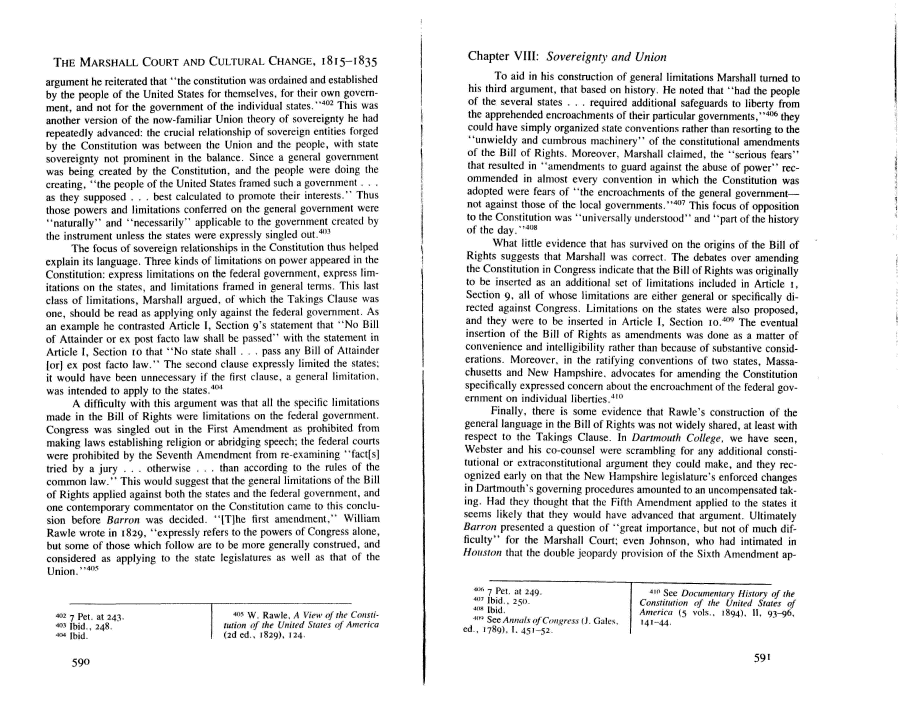|
THE MARSHALL COURT AND CULTURAL CHANGE, 1815-1835
argument he reiterated that "the constitution was ordained and established
by the people of the United States for themselves, for their own govern-
ment, and not for the government of the individual states."402 This was
another version of the now-familiar Union theory of sovereignty he had
repeatedly advanced: the crucial relationship of sovereign entities forged
by the Constitution was between the Union and the people, with state
sovereignty not prominent in the balance. Since a general government
was being created by the Constitution, and the people were doing the
creating, "the people of the United States framed such a government . . .
as they supposed . . . best calculated to promote their interests." Thus
those powers and limitations conferred on the general government were
"naturally" and "necessarily" applicable to the government created by
the instrument unless the states were expressly singled out.403
The focus of sovereign relationships in the Constitution thus helped
explain its language. Three kinds of limitations on power appeared in the
Constitution: express limitations on the federal government, express lim-
itations on the states, and limitations framed in general terms. This last
class of limitations, Marshall argued, of which the Takings Clause was
one, should be read as applying only against the federal government. As
an example he contrasted Article I, Section 9's statement that "No Bill
of Attainder or ex post facto law shall be passed" with the statement in
Article I, Section 10 that "No state shall . . . pass any Bill of Attainder
[or] ex post facto law." The second clause expressly limited the states;
it would have been unnecessary if the first clause, a general limitation,
was intended to apply to the states.404
A difficulty with this argument was that all the specific limitations
made in the Bill of Rights were limitations on the federal government.
Congress was singled out in the First Amendment as prohibited from
making laws establishing religion or abridging speech; the federal courts
were prohibited by the Seventh Amendment from re-examining "fact[s]
tried by a jury . . . otherwise . . . than according to the rules of the
common law." This would suggest that the general limitations of the Bill
of Rights applied against both the states and the federal government, and
one contemporary commentator on the Constitution came to this conclu-
sion before Barron was decided. "[T]he first amendment," William
Rawle wrote in 1829, "expressly refers to the powers of Congress alone,
but some of those which follow are to be more generally construed, and
considered as applying to the state legislatures as well as that of the
Union."405
402 7 Pet. at 243.
403 Ibid., 248.
404 Ibid.
590
40S W. Rawle, A View oj the Consti-
tution of the United States of America
(2d ed., 1829), 124.
Chapter VIII: Sovereignty and Union
To aid in his construction of general limitations Marshall turned to
his third argument, that based on history. He noted that "had the people
of the several states . . . required additional safeguards to liberty from
the apprehended encroachments of their particular governments,"406 they
could have simply organized state conventions rather than resorting to the
"unwieldy and cumbrous machinery" of the constitutional amendments
of the Bill of Rights. Moreover, Marshall claimed, the "serious fears"
that resulted in "amendments to guard against the abuse of power" rec-
ommended in almost every convention in which the Constitution was
adopted were fears of "the encroachments of the general government—
not against those of the local governments."407 This focus of opposition
to the Constitution was "universally understood" and "part of the history
of the day."408
What little evidence that has survived on the origins of the Bill of
Rights suggests that Marshall was correct. The debates over amending
the Constitution in Congress indicate that the Bill of Rights was originally
to be inserted as an additional set of limitations included in Article i,
Section 9, all of whose limitations are either general or specifically di-
rected against Congress. Limitations on the states were also proposed,
and they were to be inserted in Article I, Section io.409 The eventual
insertion of the Bill of Rights as amendments was done as a matter of
convenience and intelligibility rather than because of substantive consid-
erations. Moreover, in the ratifying conventions of two states, Massa-
chusetts and New Hampshire, advocates for amending the Constitution
specifically expressed concern about the encroachment of the federal gov-
ernment on individual liberties.410
Finally, there is some evidence that Rawle's construction of the
general language in the Bill of Rights was not widely shared, at least with
respect to the Takings Clause. In Dartmouth College, we have seen,
Webster and his co-counsel were scrambling for any additional consti-
tutional or extraconstitutional argument they could make, and they rec-
ognized early on that the New Hampshire legislature's enforced changes
in Dartmouth's governing procedures amounted to an uncompensated tak-
ing. Had they thought that the Fifth Amendment applied to the states it
seems likely that they would have advanced that argument. Ultimately
Barron presented a question of "great importance, but not of much dif-
ficulty" for the Marshall Court; even Johnson, who had intimated in
Houston that the double jeopardy provision of the Sixth Amendment ap-
406 7 Pet. at 249.
407 Ibid., 250.
408 Ibid.
4W See Annals of Congress (J. Gales,
ed., 1789), I. 45'-52.
410 See Documentary History of the
Constitution of the United States of
America (5 vols., 1894), II, 93-96,
141-44.
591
|

